Prioritization of Cartagena Coastal Military Batteries to Transform Them into Scientific, Tourist and Cultural Places of Interest: A GIS-MCDM Approach
Abstract
1. Introduction
2. Materials and Methods
2.1. Analytic Hierarchy Process (AHP)
- The decision problem is modeled as a hierarchy composed of different elements: objective to achieve (upper level), criteria and subcriteria (intermediate levels), and finally the alternatives (lower level).
- Comparisons between pairs of elements at each level of the hierarchy must be carried out, depending on the importance of each one with respect to the element at the top level.
- The global contribution of each alternative to the main objective or goal through an additive type aggregation is provided.
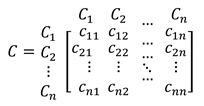
- cij ≈ (wi/wj), for all i, j = 1, 2, …, n.
- cii = 1, for all i = 1, 2, …, n.
- If cij = α ≠ 0, then cji = 1/α, for all i = 1, 2, …, n.
- If the criterion Ci becomes more relevant than Cj, then cij ≅ (wi/wj) > 1.
2.2. TOPSIS Method
3. Decision Problem: Prioritization of Coastal Military Batteries to Transform into Scientific, Touristic, and Cultural Places of Interest
3.1. Area of Study
3.2. Brief Description of the Alternatives and Criteria
3.3. Obtaining the Decision Matrix through GIS Software
3.4. Determination of the Weights of the Criteria and Subcriteria
4. Results and Discussion. Prioritization of the Alternatives
5. Conclusions
Author Contributions
Funding
Acknowledgments
Conflicts of Interest
References
- Valdés-Sánchez, A. Historia de la Artillería de Costa Española; Ministerio de Defensa, Secretaría General Técnica: Madrid, Spain, 2014. [Google Scholar]
- Pascual, F.S. El artillado del frente marítimo de la Base Naval de Cartagena como consecuencia de la amenaza de los buques acorazados. Cartagena Histórica 2003, 3, 3–25. [Google Scholar]
- Celdrán, J.A. Los espacios urbanos de la ciudad de Cartagena y sus procesos de reforma. Butlletí Del Cercle D’estudis Històrics I Socials Guillem Oliver (KessE) 2008, 42, 9–16. [Google Scholar]
- Law 16/1985 of 25 June of Spanish Heritage; BOE no. 24; Ministry of Education, Culture and Sport: Madrid, Spain, 1985; pp. 20342–20352. Available online: https://www.eui.eu/Projects/InternationalArtHeritageLaw/Documents/NationalLegislation/Spain/law16of1985.pdf (accessed on 20 May 2020).
- AFORCA Asociación de Fortalezas y Castillos de Cartagena. Available online: https://aforca.org/ (accessed on 13 January 2020).
- Muciaplaza. Available online: https://murciaplaza.com/UnasiticoconempresasdelturismodecongresosCartagenaentraencalorenFitur (accessed on 23 November 2020).
- Cope. Murcia Provincia. Cartagena. Available online: https://www.cope.es/emisoras/region-de-murcia/murcia-provincia/cartagena/noticias/cartagena-basara-candidatura-patrimonio-humanidad-las-fotificaciones-patrimonio-defensivo-20201118_1003811 (accessed on 23 November 2020).
- La Verdad. Cartagena. Available online: https://www.laverdad.es/murcia/cartagena/fortificaciones-defensivas-centran-20201119002130-ntvo.html (accessed on 23 November 2020).
- Bârcă, V. Accomplishments and failures in the management of fortress Sarmizegetusa Regia, a UNESCO world heritage monument. J. Anc. Hist. Archaeol. 2019, 6, 118–150. [Google Scholar] [CrossRef]
- Jakop, F. Reconversion of Military Wastelands: The Cultural Refuge as a Unique Scheme. J. Alp. Res. Rev. Geogr. Alp. 2019, 107, 1–10. [Google Scholar] [CrossRef]
- Fernández Alles, M.T. Las estrategias de marketing en la planificación y gestión del patrimonio cultural militar: Estudio de caso. PASOS 2019, 17, 327–341. [Google Scholar] [CrossRef]
- Rubio Bellido, C.; Gallego Pérez, P.; Llácer Pantión, R. The future of fortifications in the city of Cadiz: Opportunities and strategies for an urban regeneration. Wit Trans. Built Environ. 2012, 123, 135–147. [Google Scholar] [CrossRef]
- Almeida, J.; Costa, C.; Nunes da Silva, F. A framework for conflict analysis in spatial planning for tourism. Tour. Manag. Perspect. 2017, 24, 94–106. [Google Scholar] [CrossRef]
- Bunruamkaew, K.; Murayama, Y. Site Suitability Evaluation for Ecotourism Using GIS & AHP: A Case Study of Surat Thani Province, Thailand. Procedia Soc. Behav. Sci. 2011, 21, 269–278. [Google Scholar] [CrossRef]
- Mosadeghi, R.; Warnken, J.; Tomlinson, R.; Mirfenderesk, H. Uncertainty analysis in the application of multi-criteria decision-making methods in Australian strategic environmental decisions. J. Environ. Plan. Manag. 2013, 56, 1097–1124. [Google Scholar] [CrossRef]
- Sánchez-Lozano, J.M.; Teruel-Solano, J.; Soto-Elvira, P.L.; García-Cascales, M.S. Geographical information systems (GIS) and multi-criteria decision making (MCDM) methods for the evaluation of solar farms locations: Case study in south-eastern Spain. Renew. Sustain. Energy Rev. 2013, 24, 544–556. [Google Scholar] [CrossRef]
- Sánchez-Lozano., J.M.; García-Cascales, M.S.; Lamata, M.T. Identification and selection of potential sites for onshore wind farms development in Region of Murcia, Spain. Energy 2014, 73, 311–324. [Google Scholar] [CrossRef]
- Mallick, J. Geospatial-based soil variability and hydrological zones of Abha semi-arid mountainous watershed, Saudi Arabia. Arab. J. Geosci. 2016, 9. [Google Scholar] [CrossRef]
- Li, Y.; Lin, C.; Wang, Y.; Gao, X.; Xie, T.; Hai, R.; Wang, X.; Zhang, X. Multi-criteria evaluation method for site selection of industrial wastewater discharge in coastal regions. J. Clean. Prod. 2017, 161, 1143–1152. [Google Scholar] [CrossRef]
- Szalaj, D.; Wise, L.; Rodríguez-Climent, S.; Angélico, M.M.; Marques, V.; Chaves, C.; Silva, A.; Cabral, H. A GIS-based framework for addressing conflicting objectives in the context of an ecosystem approach to fisheries management—A case study of the Portuguese sardine fishery. ICES J. Mar. Sci. 2018, 75, 2070–2087. [Google Scholar] [CrossRef]
- Ozkan, B.; Ozceylan, E.; Saricicek, I. GIS-based MCDM modeling for landfill site suitability analysis: A comprehensive review of the literature. Environ. Sci. Pollut. Res. 2019, 26, 30711–30730. [Google Scholar] [CrossRef] [PubMed]
- Roy, B. Classement et choix en présence de points de vue multiples (la méthode ELECTRE). Rev. Française D’informatique Rech. Opérationnelle 1968, 8, 57–75. [Google Scholar]
- Brans, J.P.; Mareschal, B.; Vincke, P. PROMETHEE: A new family of outranking methods in multicriteria analysis. Opera. Res. 1984, 3, 477–490. [Google Scholar]
- Yager, R.R. On ordered weighted averaged aggregation operator in multicriteria decision making. IEEE Trans. Syst. Cybern. 1988, 18, 183–190. [Google Scholar] [CrossRef]
- Opricovic, S.; Tzeng, G.H. The compromise solution by MCDM methods: A comparative analysis of VIKOR and TOPSIS. Eur. J. Oper. Res. 2004, 156, 445–455. [Google Scholar] [CrossRef]
- Saaty, T.L. The Analytic Hierarchy Process; McGraw Hill International: New York, NY, USA, 1980. [Google Scholar]
- Hwang, C.L.; Yoon, K. Multiple Attribute Decision Methods and Applications; Springer: Berlin/Heidelberg, Germany, 1981. [Google Scholar]
- Saaty, T.L. Group Decision Making and the AHP; Springer: New York, NY, USA, 1989. [Google Scholar]
- Forman, E.H. Random indices for incomplete pairwise comparison matrices. Eur. J. Oper. Res. 1990, 48, 153–155. [Google Scholar] [CrossRef]
- Alonso, J.A.; Lamata, M.T. Consistency in the Analytic Hierarchy Process. A new approach. Int. J. Uncertain. Fuzziness Knowl.-Based Syst. 2006, 14, 445–459. [Google Scholar] [CrossRef]
- Yoon, K. Systems Selection by Multiple Attribute Decision Making. Ph.D. Thesis, Kansas State University, Manhattan, KS, USA, 1980. [Google Scholar]
- Triantaphyllou, E. Multi-Criteria Decision Making Methods: A Comparative Study; Kluwer Academic Publishers: Dordrecht, The Netherlands, 2000. [Google Scholar]
- Mardani, A.; Jusoh, A.; Nor, K.M.D.; Khalifah, Z.; Zakwan, N.; Valipour, A. Multiple criteria decision-making techniques and their applications—A review of the literature from 2000 to 2014. Ekon. Istraživanja 2015, 28, 516–571. [Google Scholar] [CrossRef]
- Transparencia Cartagena. Available online: https://www.cartagena.es/plantillas/6.asp?pt_idpag=2100 (accessed on 10 November 2020).
- QGIS Geographic Information System. Open Source Geospatial Foundation Project. Available online: http://qgis.org (accessed on 2 May 2020).
- Guerrero-Liquet, G.C.; Sánchez-Lozano, J.M.; García-Cascales, M.S.; Lamata, M.T.; Verdegay, J.L. Decision-Making for Risk Management in Sustainable Renewable Energy Facilities: A Case Study in the Dominican Republic. Sustainability 2016, 8, 455. [Google Scholar] [CrossRef]
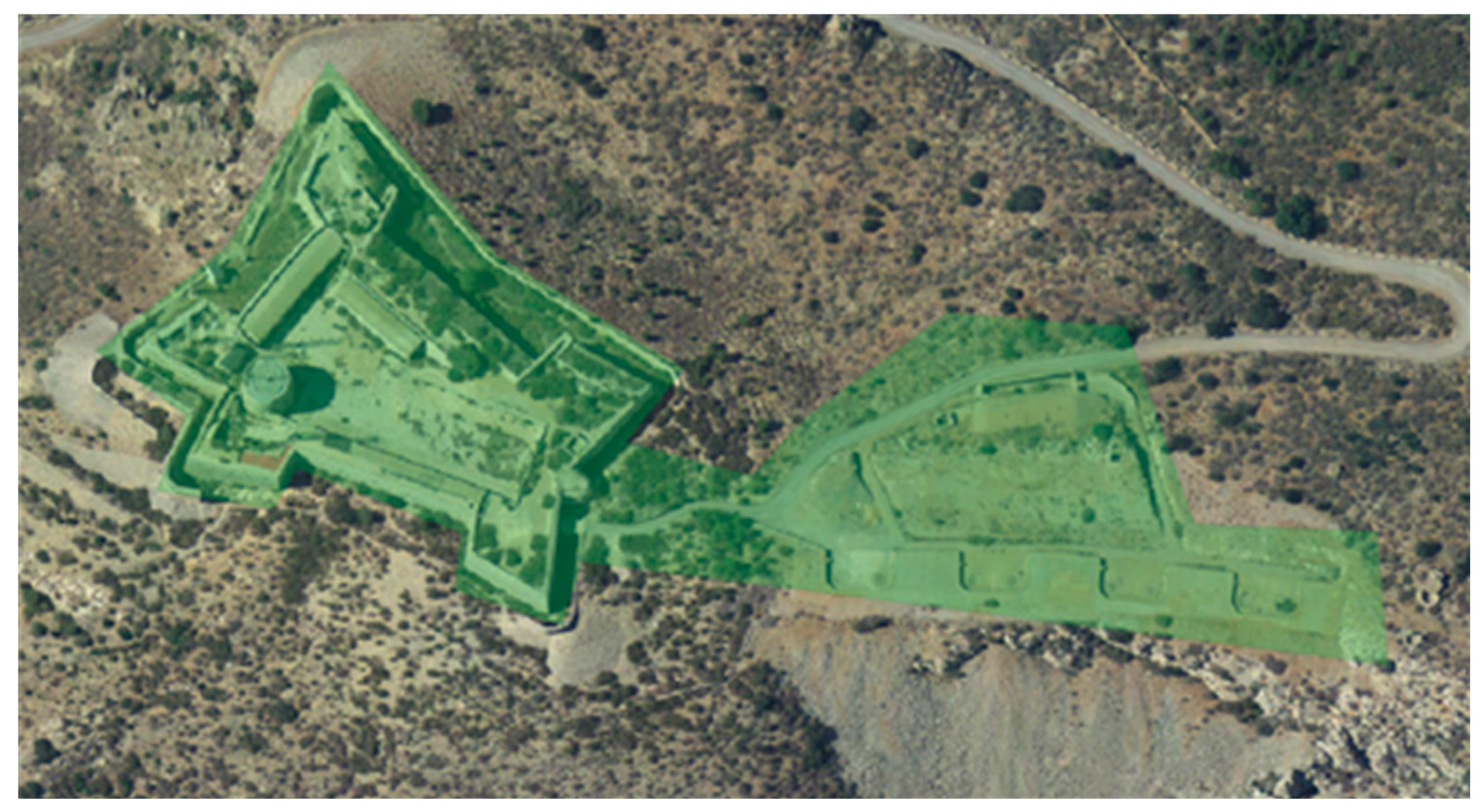
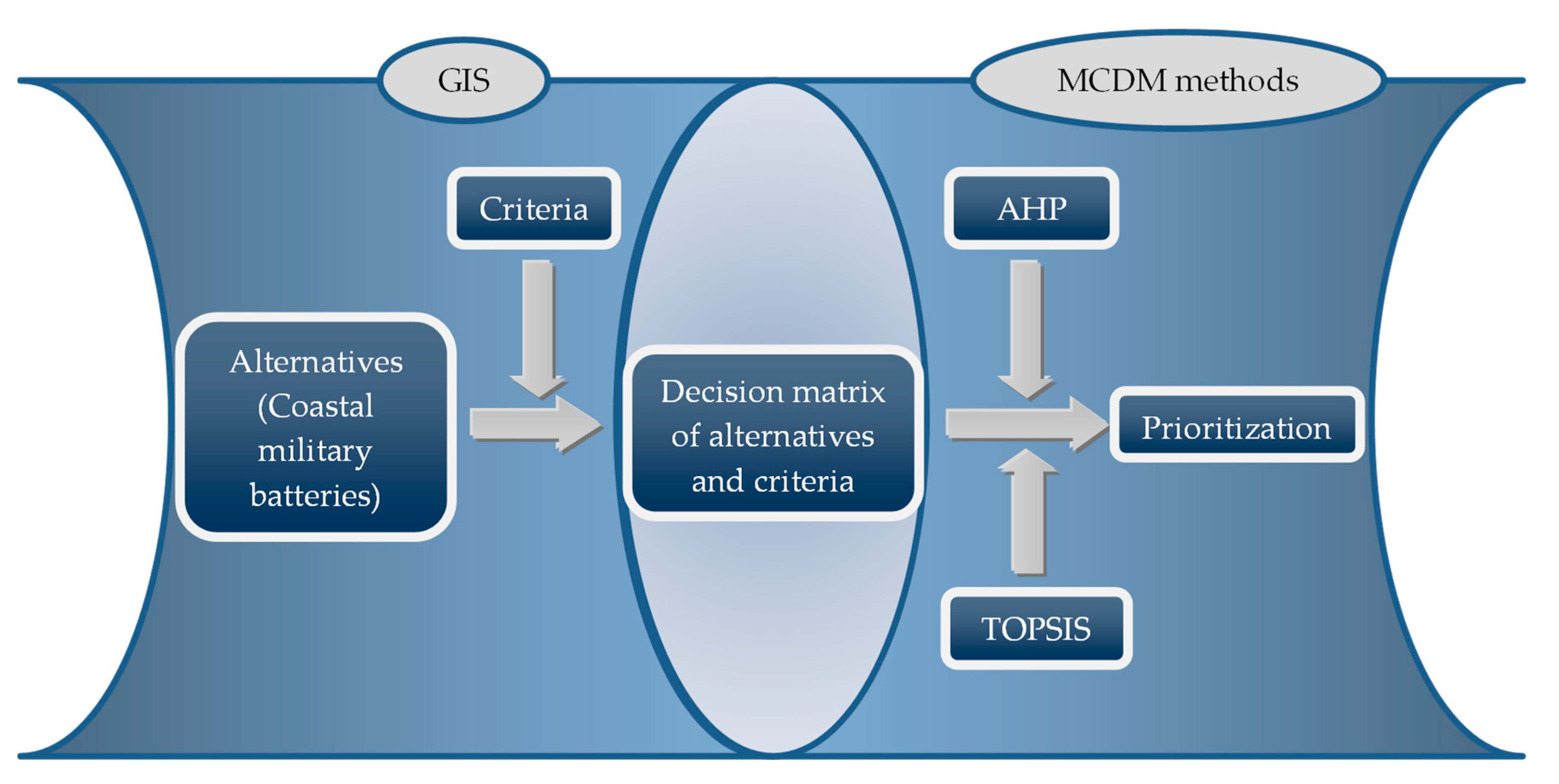
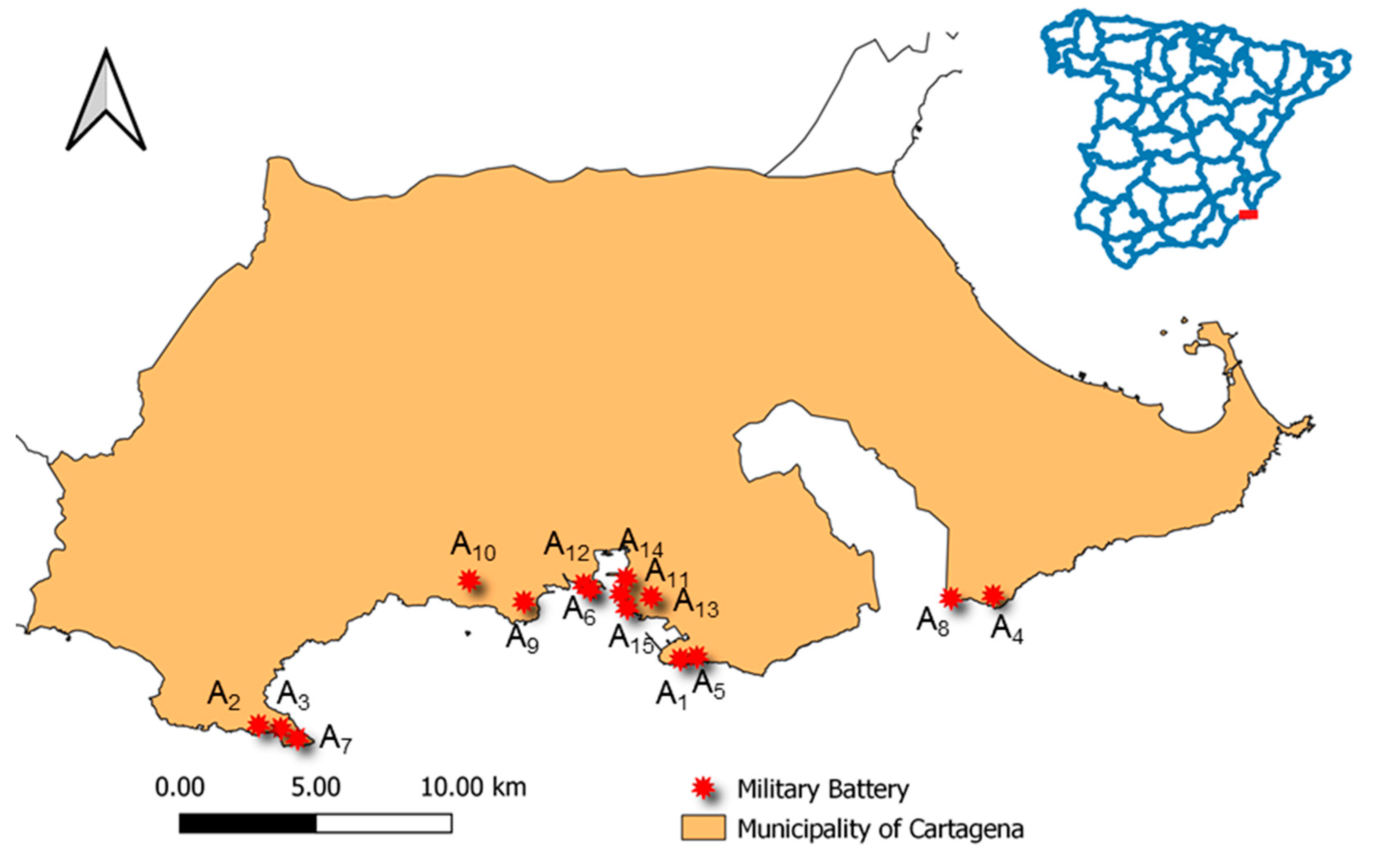
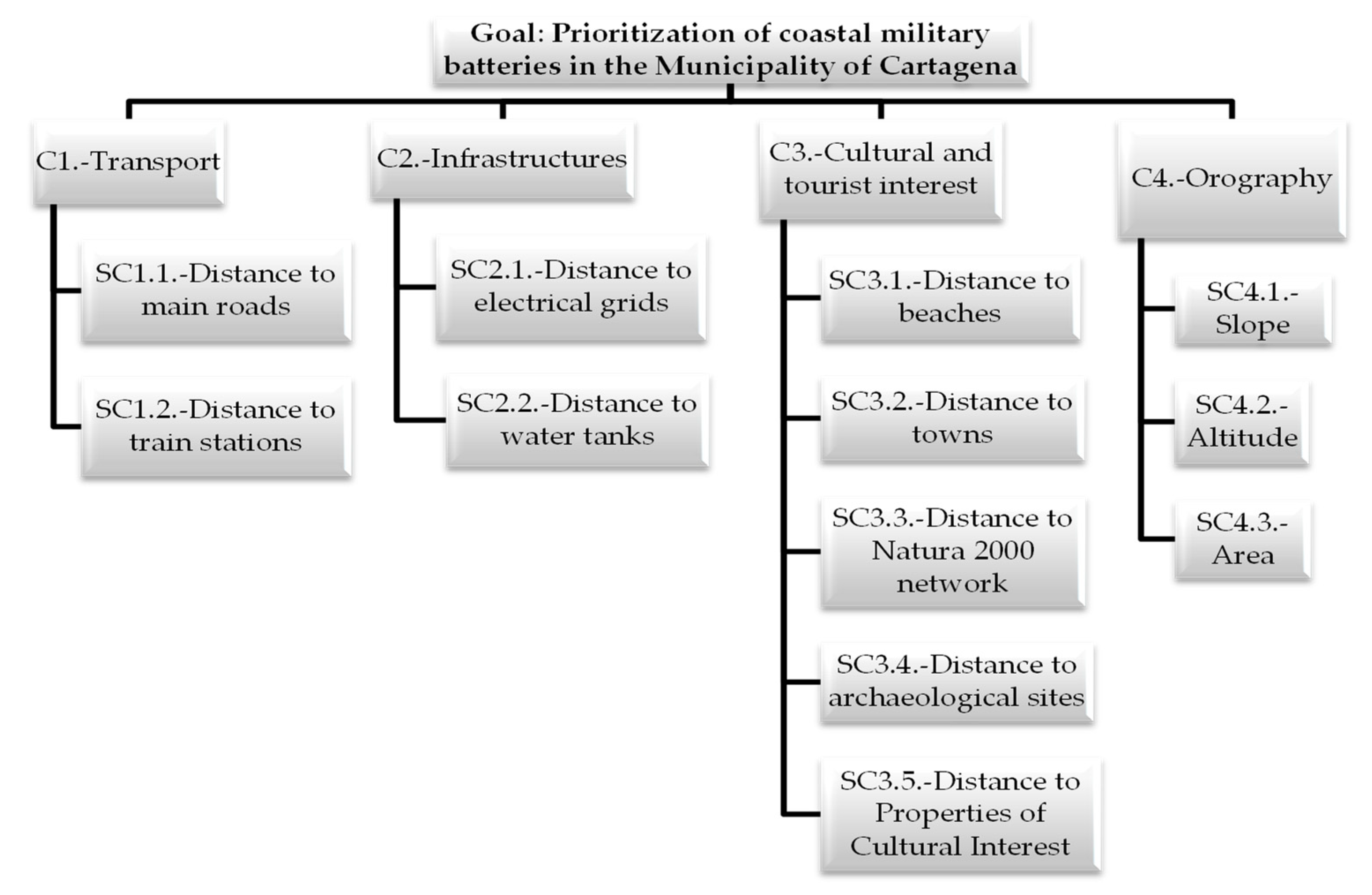
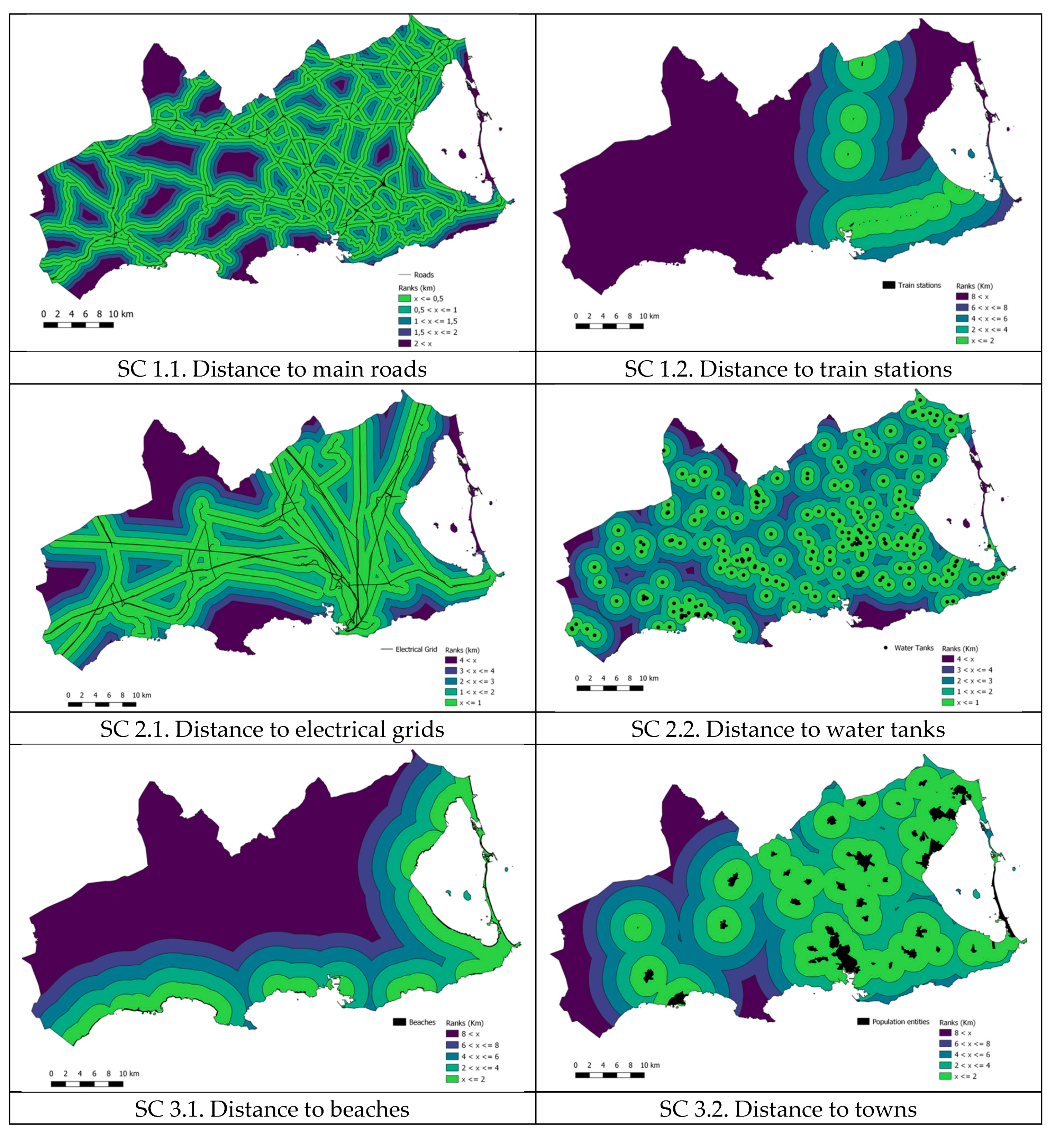
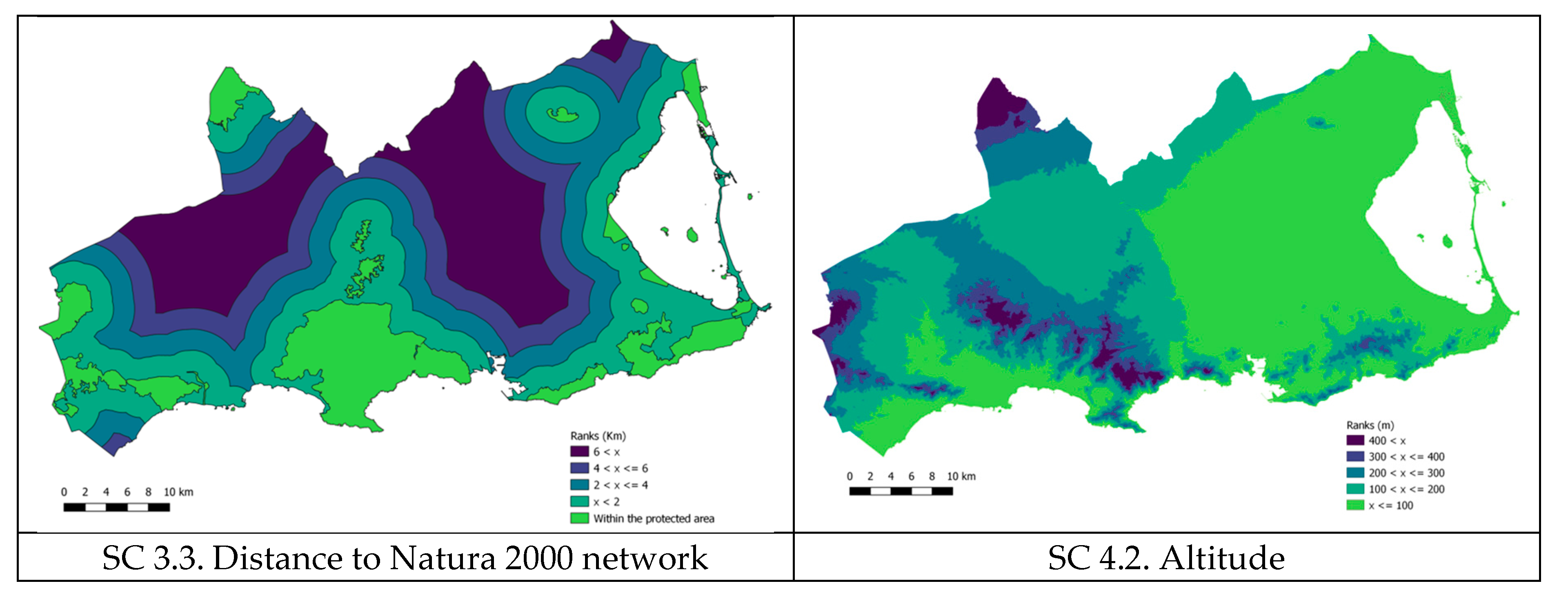
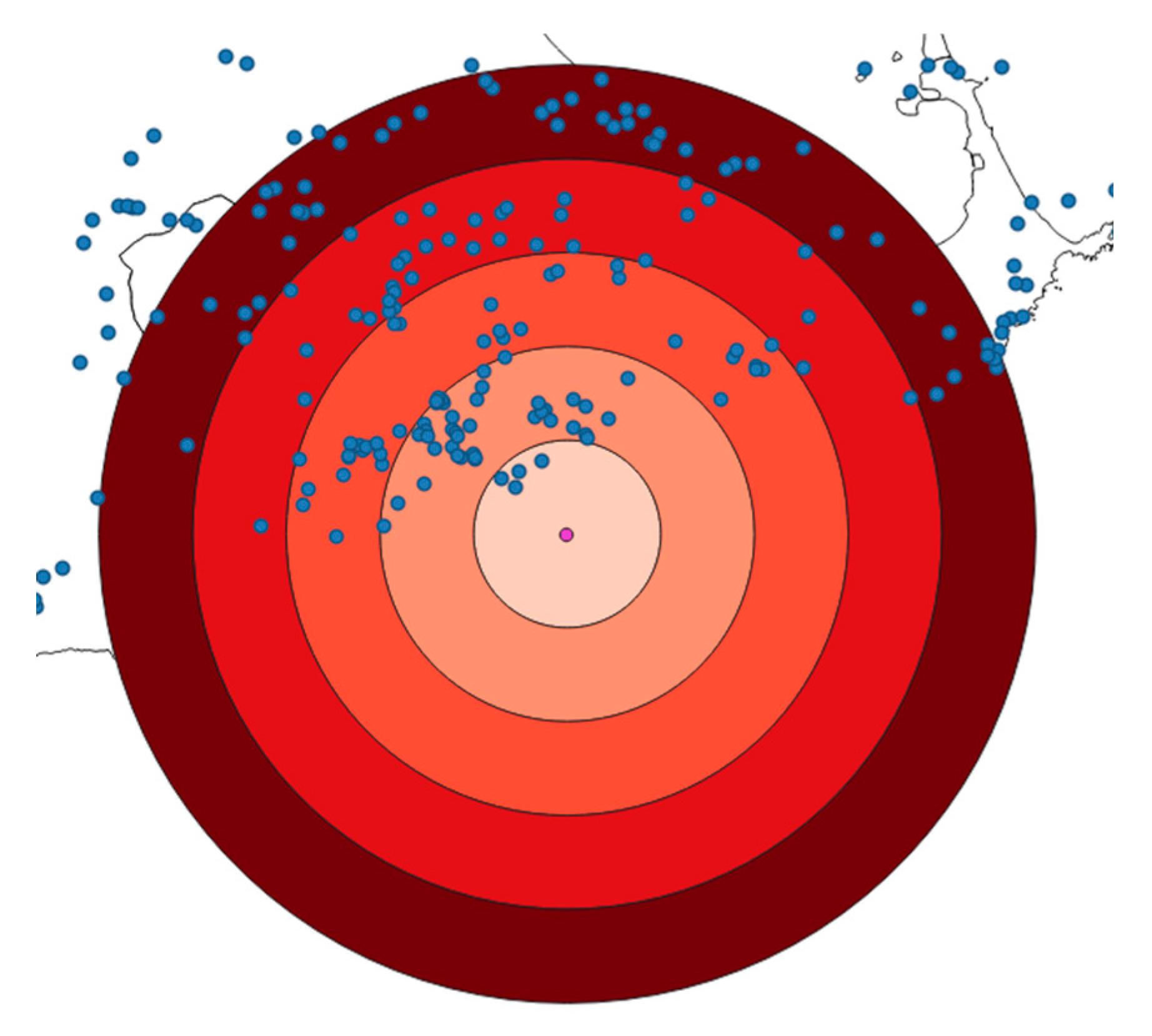

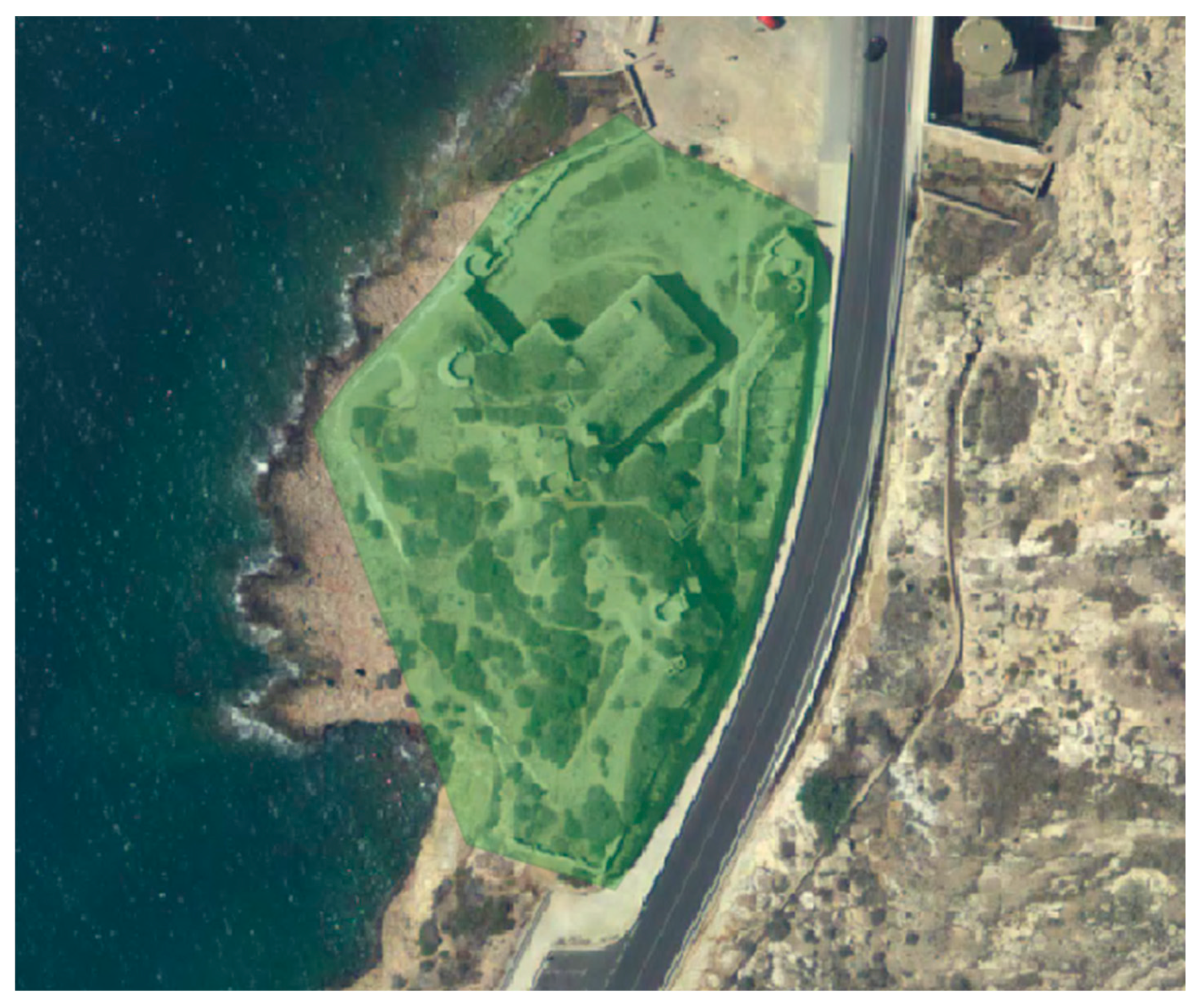
| n | 1–2 | 3 | 4 | 5 | 6 | 7 | 8 | 9 | 10 |
| RI | 0.00 | 0.5247 | 0.8816 | 1.1086 | 1.2479 | 1.3417 | 1.4057 | 1.4499 | 1.4854 |
| n | 11 | 12 | 13 | 14 | 15 | ||||
| RI | 1.5140 | 1.5365 | 1.5551 | 1.5713 | 1.5838 |
| w1 | w2 | … | wj | … | wn | |
| C1 | C2 | … | Cj | … | Cn | |
| A1 | x11 | x12 | … | x1j | … | x1n |
| A2 | x21 | x22 | … | x2j | … | x2n |
| … | … | … | … | … | … | … |
| Am | xm1 | xm2 | … | xmj | … | xmn |
| Criteria: | Criterion 1 | Criterion 2 | Criterion 3 | Criterion 4 | ||||||||
|---|---|---|---|---|---|---|---|---|---|---|---|---|
| Subcriteria: | 1.1 | 1.2 | 2.1 | 2.2 | 3.1 | 3.2 | 3.3 | 3.4 | 3.5 | 4.1 | 4.2 | 4.3 |
| A1 | 734 | 4986 | 197 | 6189 | 2924 | 4130 | 150 | 38 | 165 | 14 | 165 | 12,858 |
| A2 | 3406 | 15,097 | 9862 | 3452 | 3793 | 10,515 | 0 | 10 | 5 | 14 | 341 | 6068 |
| A3 | 4044 | 14,439 | 10,608 | 4237 | 4606 | 10,083 | 0 | 9 | 6 | 13 | 253 | 28,973 |
| A4 | 1586 | 5317 | 5331 | 1860 | 1919 | 4761 | 0 | 80 | 15 | 11 | 306 | 23,698 |
| A5 | 694 | 5034 | 270 | 6571 | 3303 | 4331 | 0 | 43 | 160 | 16 | 202 | 12,095 |
| A6 | 2220 | 2406 | 3498 | 2119 | 1327 | 1529 | 1938 | 42 | 258 | 14 | 79 | 23,646 |
| A7 | 4753 | 14,114 | 11,329 | 4952 | 5304 | 10,036 | 0 | 8 | 6 | 14 | 217 | 8653 |
| A8 | 1046 | 5045 | 4657 | 3226 | 433 | 4695 | 7 | 85 | 16 | 5 | 30 | 26,622 |
| A9 | 3231 | 4378 | 3990 | 2652 | 999 | 2704 | 0 | 33 | 219 | 9 | 166 | 18,905 |
| A10 | 2551 | 5821 | 3898 | 1652 | 844 | 2476 | 0 | 30 | 179 | 9 | 478 | 9794 |
| A11 | 1394 | 2253 | 2030 | 2930 | 208 | 1507 | 2575 | 46 | 247 | 5 | 12 | 29,583 |
| A12 | 1995 | 2369 | 3254 | 1851 | 1602 | 1402 | 1745 | 42 | 267 | 13 | 31 | 2205 |
| A13 | 963 | 2575 | 963 | 3881 | 849 | 1595 | 2359 | 51 | 237 | 15 | 288 | 20,399 |
| A14 | 789 | 1680 | 2115 | 2730 | 675 | 902 | 3086 | 50 | 281 | 3 | 17 | 4633 |
| A15 | 1836 | 2780 | 1688 | 3473 | 308 | 1946 | 2006 | 43 | 233 | 9 | 48 | 6992 |
| Criterion 1.—Transport | Criterion 2.—Infrastructures | Criterion 3.—Cultural and Touristic Interest | Criterion 4.—Orography | |
|---|---|---|---|---|
| Criterion 1 | 1 | 1 | 1 | 8 |
| Criterion 2 | 1 | 1 | 1 | 7 |
| Criterion 3 | 1 | 1 | 1 | 9 |
| Criterion 4 | 1/8 | 1/7 | 1/9 | 1 |
| Criteria | Weight (%) | Subcriteria | Weight (%) |
|---|---|---|---|
| C1.—Transport | 43.9 | 1.1.—Distance to main roads | 37.1 |
| 1.2.—Distance to train stations | 6.8 | ||
| C2.—Infrastructures | 22.2 | 2.1.—Distance to electrical grids | 12.1 |
| 2.2.—Distance to water tanks | 10.1 | ||
| C3.—Cultural and Touristic Interest | 23.7 | 3.1.—Distance to beaches | 5.0 |
| 3.2.—Distance to towns | 6.9 | ||
| 3.3.—Distance to Natura 2000 network | 5.5 | ||
| 3.4.—Distance to archaeological sites | 3.5 | ||
| 3.5.—Distance to Properties of Cultural Interest | 2.8 | ||
| C4.—Orography | 10.2 | 4.1.—Slope | 4.9 |
| 4.2.—Altitude | 2.9 | ||
| 4.3.—Area | 2.4 |
| Alternatives | TOPSIS (Ri) | Ranking |
|---|---|---|
| A1—Aguilones | 0.813 | 4 |
| A2—Atalayón | 0.333 | 13 |
| A3—Castillitos | 0.224 | 14 |
| A4—Cenizas | 0.730 | 7 |
| A5—Conejos | 0.801 | 5 |
| A6—Fajardo | 0.646 | 10 |
| A7—Jorel | 0.157 | 15 |
| A8—La Chapa | 0.815 | 3 |
| A9—Parajola | 0.477 | 12 |
| A10—Roldán | 0.591 | 11 |
| A11—San Isidoro, Santa Florentina and Santa Ana | 0.789 | 6 |
| A12—San Fulgencio | 0.694 | 9 |
| A13—General Ordóñez and San Julian | 0.828 | 2 |
| A14—San Leandro | 0.841 | 1 |
| A15—Trincabotijas | 0.727 | 8 |
Publisher’s Note: MDPI stays neutral with regard to jurisdictional claims in published maps and institutional affiliations. |
© 2020 by the authors. Licensee MDPI, Basel, Switzerland. This article is an open access article distributed under the terms and conditions of the Creative Commons Attribution (CC BY) license (http://creativecommons.org/licenses/by/4.0/).
Share and Cite
Sánchez-Lozano, J.M.; Salmerón-Vera, F.J.; Ros-Casajús, C. Prioritization of Cartagena Coastal Military Batteries to Transform Them into Scientific, Tourist and Cultural Places of Interest: A GIS-MCDM Approach. Sustainability 2020, 12, 9908. https://doi.org/10.3390/su12239908
Sánchez-Lozano JM, Salmerón-Vera FJ, Ros-Casajús C. Prioritization of Cartagena Coastal Military Batteries to Transform Them into Scientific, Tourist and Cultural Places of Interest: A GIS-MCDM Approach. Sustainability. 2020; 12(23):9908. https://doi.org/10.3390/su12239908
Chicago/Turabian StyleSánchez-Lozano, J. M., F. J. Salmerón-Vera, and C. Ros-Casajús. 2020. "Prioritization of Cartagena Coastal Military Batteries to Transform Them into Scientific, Tourist and Cultural Places of Interest: A GIS-MCDM Approach" Sustainability 12, no. 23: 9908. https://doi.org/10.3390/su12239908
APA StyleSánchez-Lozano, J. M., Salmerón-Vera, F. J., & Ros-Casajús, C. (2020). Prioritization of Cartagena Coastal Military Batteries to Transform Them into Scientific, Tourist and Cultural Places of Interest: A GIS-MCDM Approach. Sustainability, 12(23), 9908. https://doi.org/10.3390/su12239908





